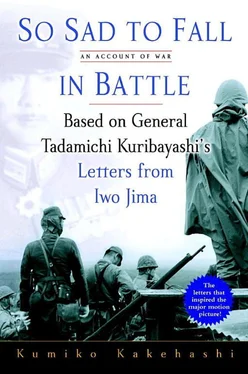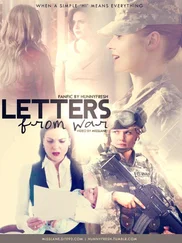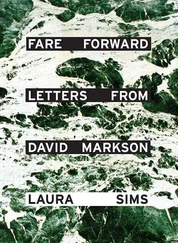This anecdote makes clear just how much the soldiers suffered from the lack of water. Once the Americans had landed and the battle began, the island’s chronic lack of water ended up costing some of the soldiers their lives.
FROM THE START OF 1945, the digging of the underground passageways known as dôkutsushiki kôtsuro (cave-style communication tunnels) began in earnest. Once these were completed, they would enable the soldiers to move from one installation to another without having to emerge aboveground.
The American assault was expected any minute, so the work was done in shifts around the clock. Unlike the caves, the underground passageways did not involve simply digging down: they had to be dug horizontally at a depth of between fifteen and twenty meters below the surface, which made the work that much harder. And there was more than just digging to the task: the men had to carry the excavated rock back along the narrow tunnels, then either carry it on their backs or put it in crates and pull it up to ground level.
All the time they were working, the soldiers suffered from headaches and nausea caused by the sulfur gas. They had gas masks, but they were an old design and wearing them made them sweat heavily and made breathing difficult, so most men preferred to do without.
The poison gas and the heat were particularly fierce in the tunnel linking Motoyama and Mount Suribachi, so the soldiers nicknamed it “the tunnel of death.” This tunnel was still unfinished when the Americans landed, with the result that contact between the two bases was cut at an early stage. This is one reason why Mount Suribachi fell faster than Kuribayashi had projected.
Forced to spend every minute of the day and night either in training or in digging defenses, the soldiers grumbled: Why did they have to suffer like this if they were going to die anyway? Some officers advocated canceling the building of the underground defenses: “We came here to make war,” they said, “not to dig holes.” But Kuribayashi was convinced that underground installations were the island’s only hope, and did not let up in the demands he put on his men.
Specialists in the construction of fortifications came out to the island to take charge and incorporate cunning techniques into the construction: tunnels would veer off at right angles halfway down their length to neutralize bomb blasts, while entrances and exits were built at different levels to improve ventilation.
“We were divided into two groups and dug toward one another from either end so that we broke through in the middle. When we did, the air suddenly started to circulate and the geothermal heat, which had made it so hard to breathe until then, suddenly cooled right down.”
So said Ôkoshi Harunori, one of the navy ground staff responsible for maintaining the transport planes that came in from the mainland. He helped dig the defenses in the intervals between servicing planes and repairing the runway. “Digging holes” was a task that involved every man on the island.
With a view to carrying out general maneuvers and fort building in a timely and rigorous fashion, all officers and men, without any exceptions, must focus on maneuvers and fort building. In particular, the bureaucratic tasks at headquarters and administration center must be significantly simplified so that commanding officers of all ranks can get out on site as much as possible and devote themselves to leading from the front.
The above is a notice that Kuribayashi issued—“Iwo Jima, Key Points for Defense and Training.” In it, he orders all the officers and men, with no exceptions, to focus on “fort building,” or the construction of defensive positions. He also emphasizes that using administrative tasks at the headquarters or in the administration section as a pretext to avoid going out into the field is unacceptable. He believed that the only way to maintain the fighting spirit and discipline of the soldiers was for their officers to “get out on site” with them.
Kuribayashi also issued another notice—“Important Points from the Division Chief”:
There is no need for units to stop working and salute when a superior officer comes around on tours of inspection. The area commander can provide a situation report. The soldiers supervising operations should not be compelled to salute but should continue supervising.
The order says that the soldiers should keep on working, rather than stopping and saluting, whenever a superior officer comes around on a tour of inspection. Kuribayashi may have believed that the salute was a key part of military discipline, but practical considerations were paramount, and he was never a slave to form.
PHOTOGRAPHS OF KURIBAYASHI at this time show him wearing a soldier’s open-necked shirt and jikatabi and carrying a thin cane instead of a sword. He made his daily circuit of the defenses dressed like this. He was always unarmed, not even carrying a pistol.
His favorite cane had notches on it, and when he went to check the progress of the work on the defenses, he would use it to make various measurements. Sometimes he would crawl into the tunnels on his stomach to make sure there were no blind spots; sometimes he would measure the thickness of the sandbags and direct the men to “make it thicker here.” He would also get deeply involved during training, demonstrating how things should be done, even helping individual soldiers with their shooting action.
In the oral survey conducted by the War Department of the National Institute of Defense Studies after the war, Major Fujiwara Tamaki, a battalion chief of the 17th Independent Mixed Regiment who returned to the mainland at the end of January 1945 before the American assault, recalled: “Once it was possible to live in the bunkers, Kuribayashi would sit down on the tuff stone like everybody else and get on with his work.”
Survivors often mention in their accounts how Kuribayashi would talk to them directly or give them the cigarettes that were a gift from the emperor. There are also anecdotes in which soldiers were startled to discover that the person who suddenly turned up unarmed and wearing common jikatabi was none other than their commander in chief, or ended up being escorted to their unit by Kuribayashi after getting lost on their way around the island.
Ishii Shûji, who, as a newspaperman in Tokyo, had known Kuribayashi, wrote about his experience of meeting him again as a recruit on Iwo Jima in Iô-Tô ni Ikiru .
That day I was walking along in front of the adjutants’ room pushing my bicycle, when a general holding a cane came up on my right. “Uh-oh,” I thought, and immediately stood stiffly to attention and saluted. The general in question was unarmed and quite old. It turned out that this old man was our direct commander in chief, Lieutenant General Kuribayashi.
The lieutenant general walked past me and said “Keep up the good work.” When I heard that “Keep up the good work,” I thought “No, it can’t be” and took a careful look at his face; it was then that I realized it was Lieutenant General Kuribayashi whom I had met often in the course of my work when he commanded the Second Imperial Guards Home Division. So it was that Kuribayashi! [omission]
When the lieutenant general heard my voice, he walked back two or three steps, and looked me in the face. “Ah, you work for that newspaper—Ish-, Ish-… Got it, it’s Mister Ishii.” And he smiled.
“Yes, I’m Ishii. I used to work at the Mainichi Shimbun. ” On my side I was thrilled that he had not forgotten who I was, and I spoke this unnecessarily loudly.
“So, young Mister Ishii, is it? Funny place for us to meet, eh! When did you get here?—Oh, of course, of course, I suppose it was only about three months ago. When you’ve got time, drop in for a visit,” he said and then slowly went on his way.
Читать дальше












